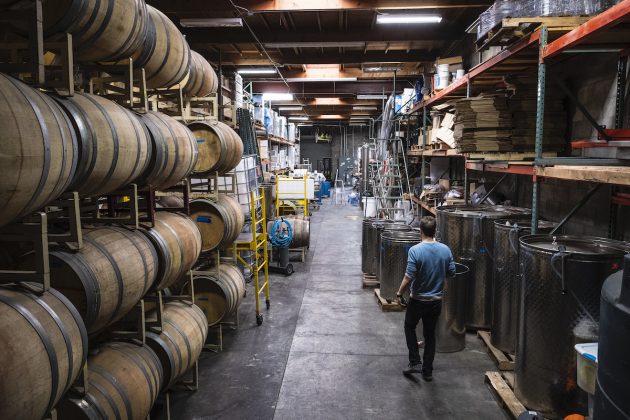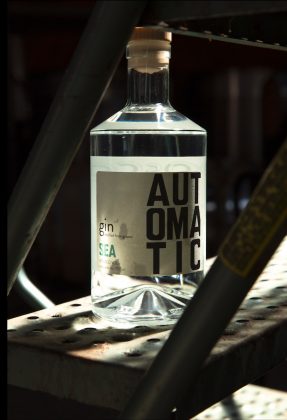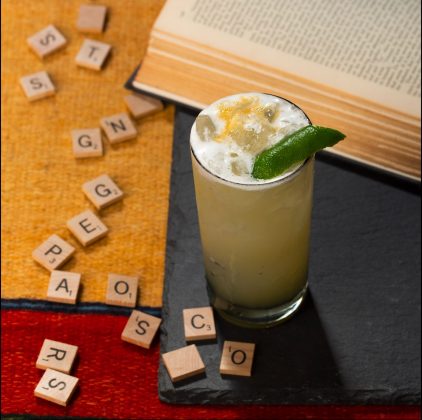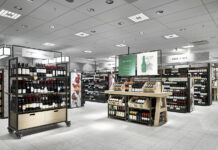In early 2016, a pioneering distillery in the heart of Uptown Oakland, CA quickly became a cult favorite. This is Oakland Spirits Co., OsCo for short. Its most well-known spirits are Sea Gin made with foraged Nori, coastal bay leaf and sage; or clear brandy vapor infused with Garam Marsala, cilantro and Assam tea.
Last year, OsCo took one step further, in collaboration with Hog Island Oyster Co., to release the AUTOMATIC Halfshell gin, using the latter’s proprietary Sweetwater oysters from Tomales Bay.
I recently had the opportunity to sit down with Adam Nelson and Michael Pierce, founders at OsCo. Our edited conversation is below.
What inspired you and your partners to establish Oakland Spirits Co., or OsCo?
The iconic and creatively industrious city of Oakland needed a distillery to represent its moxie and passion. We felt the craft bartenders were getting tired of the same-old-same-old and sugar dominated cocktails, spirits and liqueurs. OsCo was created to build a bridge between these craft-cocktail innovators — both trade and home bartenders — and savory spirits that infuse flavor profiles that in 2016 were either underrepresented or non-existent.
We have never released a spirit without getting critical feedback and buy-in from the most well-respected cocktail and bar influencers in the Bay Area and beyond. OsCo has collaborated on two of our seven spirits with iconic and well-respected bars and bar managers. The results are our glasshouse “Trade Winds” brandy (cilantro, garam masala and Assam tea flavored) and AUTOMATIC Halfshell Oyster Gin. The former was a collaboration with Adam Stemmler at East Bay Spice Company and the latter with Saul Ranella at Hog Island Oyster Co.
Four of our six current expressions present flavors and use botanicals that have never been available in the history of spirits. This makes us very unique compared to others craft distilleries.
Tell us about the Sea Gin distillation process.
We use a 650 L copper pot still made by Artisan Still Design. It’s gently heated with a bain marie (we use glycol in the jacket), has a French turnip-head and the gin basket is the second column. For our unique and popular AUTOMATIC Sea Gin, we soak a large amount foraged Mendocino Nori (Japanese for seaweed) in the pot with a mix of 176 proof grape-neutral brandy and filtered water. We slowly turn up the heat until it’s hot enough to start breaking down the Nori, then we shut it off for the evening. The next morning we load the gin basket with juniper, California coastal bay leaf and sage, lemon peel and a few other ingredients. We collect very little heads as a percentage of the entire run as our neutral is already extremely clean. We run slow and low, influence output rate through the pot temp’s dance with the agitator speed, and let our distillations go for as long as they need. We cut the tails based on output proof, pot temp and taste.
Tell us more about the unique collaboration with Hog Island Oyster Co.
In early 2019 I [Michael] was on the drinking side of the stick at one of my favorite bars. Saul Ranella, bar manager at Hog Island Oysters, and I were discussing how he and his guests loved our Sea Gin but wouldn’t it be awesome to go deeper. The conversation quickly turned to distilling a gin through their workhorse Tomales Bay oyster, the Sweetwater. Neither of us could remember ever hearing about any gins distilled through oysters. If it wasn’t a pipe dream it was certainly an opportunity.
There were numerous hurdles to overcome. Foremost, if this was doable from a TTB formula approval standpoint. Why had no American distillery ever legally produced and sold one? It seemed daunting to say the least and realistically an impossible goal.
The prototyping effort was an OsCo internal collaborative effort and done on our little 2 L, glass perfume still. We were able to crank out eight different recipes in about two weeks. We were committed to using the entire oyster (albeit smashed up). Meat, liquor, shell and all. This added some bridge-flavor challenges that honesty, we revel in tackling. These collaborations push us to solve previously unchallenged flavor riddles and it’s our most inspiring space to work in.
Once we had a recipe we all loved, we submitted it to the TTB for approval. To our surprise, this process was pretty darn seamless and quick. The TTB asked us to clarify whether we meant oyster mushrooms or oyster bivalves. Once we did, they made one easy processing request and we were on our way. The COLA (certificate for label approval) department shot down our first few names but for good reason. AUTOMATIC Oyster Gin violated their rules around having a specific botanical ingredient in the name and AUTOMATIC Tomales Gin didn’t fly because of naming regulations around places where botanicals are sourced. Our assistant distiller blurted out “Halfshell Gin” one day and it stuck. Thankfully the TTB agreed they (and their regulations) liked it as well.
At first, Hog Island Oyster Co. did not want their name on the bottle as that would have complicated and slowed down the launch significantly. They agreed to buy the whole first run as it was going to be their workhorse cocktail gin for both of their super busy locations. Now that it’s become a hit, they are changing their tune about possibly wanting to co-brand although we enjoy owning the brand and expression outright. We delivered their first 15 cases in mid-June of 2019.
As a result of being true innovators and first-to-market in the oyster gin category we are a bit protective of the recipe. We use our 650 L Artisan Still Design copper pot still. We smash the oysters to smithereens with a big, iron landscape tamper and dump them directly in the pot with our neutral grape spirit and filtered water blend. We add whole juniper berries, smashed celery root bulbs, and a few other proprietary bridge botanicals to the pot and—like the Sea Gin process—heat the pot up to a specified temperature then turn it off, and let it sit overnight. The next day we add a host of unique botanicals to the gin basket (the two we will reveal are fresh lemons halves and a ton of dried French tarragon) and, like all of our gins, run it slow and low.
Copper pulls out impurities and so the lipids and fats in the oyster meat and liquor don’t fully aromatize through the vapor trail. The Halfshell Gin aroma presents the shell-like minerality and alkalinity of the Sweetwaters but the briny, savory, bay-adjacent oyster funk is latent in the straight spirit. That is, until it’s used in any cocktails that have additives with sugar or added sweetness. Think Bianco Vermouth, tonic, Chartreuse, Luxardo, Chareau Aloe Liqueur, etc. Once these classic gin cocktail ingredients meld with the Halfshell Gin, the sea-like aroma and taste of the oyster rears its lovely head.
How has the COVID-19 pandemic affected your business?
Around 70% of our wholesale business is/was on-premise (restaurants and bars). We supplement this wholesale with tasting room and event sales (direct to consumer). After Alameda County issued their shelter in place (SIP) order on March 16th, all bars and restaurants were forced to close. This was followed quickly by a statewide California SIP, which effectively wiped out the latter two revenue streams.
Any plans for expansion into other markets/states is now no longer an option. It’s so hard to predict anything more than a few days out because of the uncertainty, but if things get back to normal by early 2021 we might be able to pull off expanding into other markets.
Our launch with our new distributor (Young’s Market Co./RNDC) February 1st was going great, and we were poised to quickly double or triple sales. Until, suddenly, we weren’t.
Spirit drinkers should know that just because alcohol consumption is way up in the US since mid-March, that increase is really only benefiting the larger, more established brands, the ones that have a stranglehold on corporate and formula retail shelves. Craft distilleries (and breweries and wineries) are hurting badly.
When things eventually open back up the craft-beverage landscape will likely have 30–40% less participants. That said, we are seeing an increased demand for local craft brands at smaller non-chain retail stores. This is nice but doesn’t make much of a dent in the precipitous drop in sales from the loss of on-premise business for brands like ours.
Tease us with the next innovation you are working on.
In early January we started raising money and planning a new brand focused around RTD (Ready to Drink) canned cocktails. We love the playfulness and freedom of the category and what was an already meteoric growth trajectory is now a rocketship, post-pandemic.
We are still working on flavor profiles and are playing around with making low-ABV cocktails that taste, feel and flood your memories with emotions of life’s indelible moments: Rain, Happiness, The Beach, Vacation, etc.













